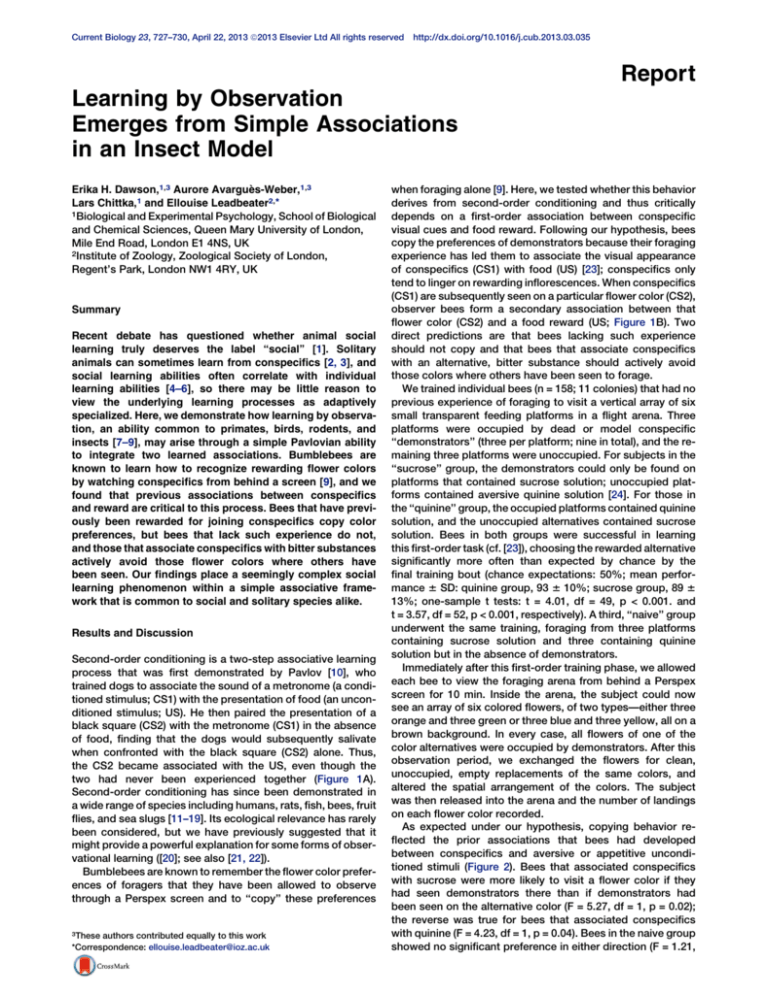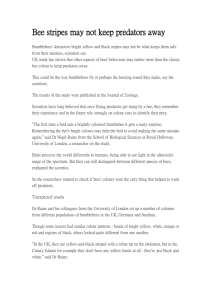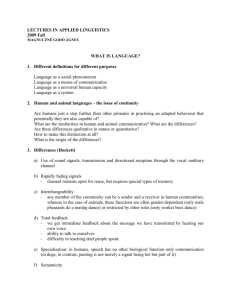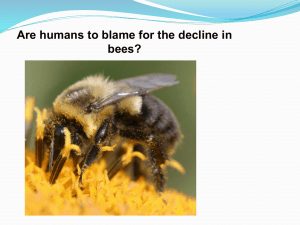
Current Biology 23, 727–730, April 22, 2013 ª2013 Elsevier Ltd All rights reserved
http://dx.doi.org/10.1016/j.cub.2013.03.035
Report
Learning by Observation
Emerges from Simple Associations
in an Insect Model
Erika H. Dawson,1,3 Aurore Avarguès-Weber,1,3
Lars Chittka,1 and Ellouise Leadbeater2,*
1Biological and Experimental Psychology, School of Biological
and Chemical Sciences, Queen Mary University of London,
Mile End Road, London E1 4NS, UK
2Institute of Zoology, Zoological Society of London,
Regent’s Park, London NW1 4RY, UK
Summary
Recent debate has questioned whether animal social
learning truly deserves the label ‘‘social’’ [1]. Solitary
animals can sometimes learn from conspecifics [2, 3], and
social learning abilities often correlate with individual
learning abilities [4–6], so there may be little reason to
view the underlying learning processes as adaptively
specialized. Here, we demonstrate how learning by observation, an ability common to primates, birds, rodents, and
insects [7–9], may arise through a simple Pavlovian ability
to integrate two learned associations. Bumblebees are
known to learn how to recognize rewarding flower colors
by watching conspecifics from behind a screen [9], and we
found that previous associations between conspecifics
and reward are critical to this process. Bees that have previously been rewarded for joining conspecifics copy color
preferences, but bees that lack such experience do not,
and those that associate conspecifics with bitter substances
actively avoid those flower colors where others have
been seen. Our findings place a seemingly complex social
learning phenomenon within a simple associative framework that is common to social and solitary species alike.
Results and Discussion
Second-order conditioning is a two-step associative learning
process that was first demonstrated by Pavlov [10], who
trained dogs to associate the sound of a metronome (a conditioned stimulus; CS1) with the presentation of food (an unconditioned stimulus; US). He then paired the presentation of a
black square (CS2) with the metronome (CS1) in the absence
of food, finding that the dogs would subsequently salivate
when confronted with the black square (CS2) alone. Thus,
the CS2 became associated with the US, even though the
two had never been experienced together (Figure 1A).
Second-order conditioning has since been demonstrated in
a wide range of species including humans, rats, fish, bees, fruit
flies, and sea slugs [11–19]. Its ecological relevance has rarely
been considered, but we have previously suggested that it
might provide a powerful explanation for some forms of observational learning ([20]; see also [21, 22]).
Bumblebees are known to remember the flower color preferences of foragers that they have been allowed to observe
through a Perspex screen and to ‘‘copy’’ these preferences
3These authors contributed equally to this work
*Correspondence: ellouise.leadbeater@ioz.ac.uk
when foraging alone [9]. Here, we tested whether this behavior
derives from second-order conditioning and thus critically
depends on a first-order association between conspecific
visual cues and food reward. Following our hypothesis, bees
copy the preferences of demonstrators because their foraging
experience has led them to associate the visual appearance
of conspecifics (CS1) with food (US) [23]; conspecifics only
tend to linger on rewarding inflorescences. When conspecifics
(CS1) are subsequently seen on a particular flower color (CS2),
observer bees form a secondary association between that
flower color (CS2) and a food reward (US; Figure 1B). Two
direct predictions are that bees lacking such experience
should not copy and that bees that associate conspecifics
with an alternative, bitter substance should actively avoid
those colors where others have been seen to forage.
We trained individual bees (n = 158; 11 colonies) that had no
previous experience of foraging to visit a vertical array of six
small transparent feeding platforms in a flight arena. Three
platforms were occupied by dead or model conspecific
‘‘demonstrators’’ (three per platform; nine in total), and the remaining three platforms were unoccupied. For subjects in the
‘‘sucrose’’ group, the demonstrators could only be found on
platforms that contained sucrose solution; unoccupied platforms contained aversive quinine solution [24]. For those in
the ‘‘quinine’’ group, the occupied platforms contained quinine
solution, and the unoccupied alternatives contained sucrose
solution. Bees in both groups were successful in learning
this first-order task (cf. [23]), choosing the rewarded alternative
significantly more often than expected by chance by the
final training bout (chance expectations: 50%; mean performance 6 SD: quinine group, 93 6 10%; sucrose group, 89 6
13%; one-sample t tests: t = 4.01, df = 49, p < 0.001. and
t = 3.57, df = 52, p < 0.001, respectively). A third, ‘‘naive’’ group
underwent the same training, foraging from three platforms
containing sucrose solution and three containing quinine
solution but in the absence of demonstrators.
Immediately after this first-order training phase, we allowed
each bee to view the foraging arena from behind a Perspex
screen for 10 min. Inside the arena, the subject could now
see an array of six colored flowers, of two types—either three
orange and three green or three blue and three yellow, all on a
brown background. In every case, all flowers of one of the
color alternatives were occupied by demonstrators. After this
observation period, we exchanged the flowers for clean,
unoccupied, empty replacements of the same colors, and
altered the spatial arrangement of the colors. The subject
was then released into the arena and the number of landings
on each flower color recorded.
As expected under our hypothesis, copying behavior reflected the prior associations that bees had developed
between conspecifics and aversive or appetitive unconditioned stimuli (Figure 2). Bees that associated conspecifics
with sucrose were more likely to visit a flower color if they
had seen demonstrators there than if demonstrators had
been seen on the alternative color (F = 5.27, df = 1, p = 0.02);
the reverse was true for bees that associated conspecifics
with quinine (F = 4.23, df = 1, p = 0.04). Bees in the naive group
showed no significant preference in either direction (F = 1.21,
Current Biology Vol 23 No 8
728
A
A
B
B
Figure 1. Second-Order Conditioning
(A) Pavlov’s dogs learned to salivate on presentation of a black square that
had never been paired directly with food.
(B) The same mechanism is suggested to underlie observational learning in
bumblebees.
df = 1, p = 0.28). Data for the orange/green and blue/yellow
choice tests were pooled because we found no significant
effect of choice test on the data (F < 1.5, df = 1, p > 0.2 in
each case).
Social learning about food typically involves attraction to
feeding sites or food types. However, previous authors have
pointed out that if social information use is a form of associative learning, animals should be able to learn negative associations as well as positive ones [1, 25, 26]. In other words, if the
presence of conspecifics is inversely correlated with food
quality or availability, animals should avoid popular resources.
Our data provide empirical evidence that negative relationships can indeed lead to avoidance behavior. Furthermore, it
is not unrealistic to expect that wild foraging bees might sometimes learn to negatively associate conspecifics with food [27],
because conspecifics drain flowers. We extrapolate our
finding with caution, because an actively aversive stimulus
such as quinine may be more effective in eliciting avoidance
behavior than simply a lack of food. Nonetheless, the possibility that wild bees may be more likely to avoid flower species
where conspecifics have been seen, rather than prefer them,
deserves further study.
In traditional social learning terminology, color copying in
bumblebees might be termed ‘‘stimulus enhancement’’ [28],
whereby the presence of demonstrator bees exposes the
observer to the flower color, perhaps by drawing attention to
it. Alternatively, if the presence of the demonstrator exposes
the observers to the association between that flower color
and reward, the term ‘‘observational conditioning’’ [7] would
be used. Although both mechanisms can be encompassed
within an individual learning framework (single-stimulus
learning or stimulus-stimulus learning, respectively [24]), these
explanations do not address the question of why the demonstrator’s behavior brings about such exposure. The assumption is that selection has led social animals to treat conspecific
behavior as a biologically important stimulus. Second-order
conditioning presupposes no such preprogrammed response
to social cues [24].
Our findings do not imply that color-preference copying in
bumblebees involves no adaptive specialization. Individuals
C
Figure 2. Flower Color Preferences according to the Presence of
Demonstrators
(A–C) Sucrose group (A), quinine group (B), and naive group (C). Data for
orange/green and blue/yellow choice tests were pooled because no significant differences were found between the two experiments. Thus,
‘‘color A’’ represents orange or blue, respectively, and ‘‘color B’’ represents
green or yellow. Preferences are the proportion of all landings made during
the test that were directed to color A for each bee (n=158 bees). Note that
preferences for color B are the inverse of preferences for color A and so
were not analyzed separately. Bars represent SE. * denotes p < 0.05; ns
denotes not statistically significant (p > 0.05).
may be more likely to learn first-order associations involving
conspecifics if they have visual systems that are adapted
to perceive social cues, perceptual systems that prioritize
them, or motivational systems that encourage proximity
[1, 29, 30], although there is limited evidence that this is the
case in bumblebees [31]. In other words, input mechanisms
(cf. ‘‘data acquisition mechanisms’’ [32]) may well be adapted
to preferentially process social information [1]. Rather, the
novelty of our findings lies in showing that, although selection
might favor animals that prioritize social stimuli, associative
learning can explain why these stimuli acquire relevance.
Thus, any animal that is capable of second-order conditioning
should also be capable of this form of observational learning in
the right circumstances.
We have shown that learning by observation can develop
if animals learn to associate food, a biologically important
Second-Order Conditioning in Bee Social Learning
729
stimulus, with the visual presence of conspecifics. When these
visual cues are then observed in the context of another biological stimulus, that second stimulus also becomes associated
with food through a simple Pavlovian process. Importantly,
there is no reason that first-order conditioned stimuli should
be generated by conspecifics exclusively. If heterospecific
behavior can be used to predict reward, second-order conditioning provides a means by which animals can capitalize upon
such information, and there is growing evidence to suggest
that social learning indeed traverses species boundaries
[31, 33–36].
Experimental Procedures
Test Subjects and Arena
All experimental procedures were approved by the Zoological Society of
London Ethics Committee. Eleven bumblebee (Bombus terrestris) colonies
(provided courtesy of Syngenta Bioline Bees, Weert, the Netherlands) were
each housed in wooden nest boxes (28 3 16 3 11 cm) that were connected
to a flight arena (117 3 72 3 30 cm) by a Plexiglas tube. Prior to experimentation, bees were fed via gravity feeders within the nestbox and individually
marked with numbered tags. Because our bumblebee nestboxes are kept
dark, individuals had no prior opportunity to associate the visual presence
of conspecifics with food.
Phase One: Training
We trained over 250 bees, and 158 completed the test without losing motivation to forage (n = 54, 50, and 54 in sucrose, naive, and quinine groups,
respectively). Subjects were trained alone. Each was permitted to visit an
array of six transparent platform feeders (1.5 3 1 3 1.5 cm; two vertical
rows of three platforms each, mounted on a cardboard background). Nine
demonstrators (see below) were mounted around three platforms (three
demonstrators per platform, two pinned and one dangling by thread from
a pin to allow movement when a fan was turned on); the remaining three
were unoccupied.
Model bees, or dead unrelated worker bees killed by freezing on the day
prior to experimentation, served as demonstrators. Models were made from
oven-baked clay (Fimo soft, Staedtler) and painted to reflect natural
Bombus terrestris color properties according to bumblebee color space
[37, 38]. We used models to avoid killing excessive numbers of bees; previous work has found that models, dead bees, and live bees all elicit equivalent copying behavior [9, 39]. Models do not produce scent, but our test
phase (see below) involved viewing from behind a screen, so only visual
cues were available in both cases.
In the sucrose treatment, the three occupied platforms contained 20 ml
of 2 M sucrose solution, and the unoccupied platforms contained 20 ml
of saturated quinine hemisulphate solution. In the quinine group, occupied
platforms contained quinine and unoccupied platforms contained sucrose
solution. Bees in the naive treatment visited the same array, where
three platforms contained sucrose solution and three quinine solution,
but with no demonstrators present. A small hand fan (‘‘The Cooler’’
by Design Go; 8.5 3 4.5 3 4 cm) was turned on during the training
phase to create the appearance of movement by the demonstrator bees
(following [9]).
When bees have collected a full crop of sucrose solution, they deposit it in
the nest before returning to forage again. The test bee was permitted to
return eight times during the training phase; each time the position of the
occupied and unoccupied platforms was changed to avoid subjects solely
learning the position of rewarding flowers. Platforms were replenished every
time they were depleted and the number of landings on occupied and unoccupied platforms was recorded.
three blue and three yellow flowers. Within the choice set, colors were
randomly allocated to platforms. The color contrast between each color
and the background, calculated in a color space for bees [37, 38], was
slightly higher for blue (0.21) than for yellow (0.18) and moderately higher
for orange (0.2) than for green (0.14), where the maximum theoretical
contrast between any color and its background is 1. Each feeding platform
was filled with 20 ml of water.
Three bee demonstrators were attached to flowers of one color, in the
same positions as described in the training phase setup. Once again, a
fan was used to move the hanging demonstrators. Test subjects were
allowed to view the floral array, with demonstrators, for a period of
10 min. The vertical arrangement of the array meant that all flowers could
be viewed equally from behind the screen. Halfway through this observation
period, the position of the orange and green or the blue and yellow flowers
was reversed, to minimize the likelihood that bees associated demonstrators with locations rather than colors.
Phase Three: Testing
Immediately after the observation period, the floral array was replaced with
an identical floral array, save that the position of each flower color was
randomly reallocated, and, importantly, no demonstrators were present.
All feeding platforms were filled with 20 ml of water. The test subject was
released into the arena, and the landing choices of the subject were
recorded for a 5 min period following (and including) the first landing on a
flower. If no landings were made within 10 min of the subject being released,
the test was stopped.
Color Preference Test
Our experimental design incorporated two types of choice test: orange/
green and blue/yellow, and our response variables were therefore ‘‘preference for orange’’ or ‘‘preference for blue’’ respectively. To compare innate
preferences for these colors, we tested 30 entirely naive bees that had never
previously seen any colored stimuli on each pair of colors. Orange is moderately preferred over green, and blue over yellow (means 6 SE: 0.64 6 0.04
and 0.60 6 0.05, respectively), as one might predict from differences in color
contrast to the background (see ‘‘Phase Two: Observation’’ section above).
These preferences for orange and blue do not differ significantly from one
another (F < 0.01, df = 1, p = 0.95), and correspondingly, data were pooled
for the two choice tests, with ‘‘choice test’’ included as a predictor in each
model.
Statistical Tests
Our hypothesis predicts that preferences for any flower color should be
relatively greater when sucrose-associated demonstrators are seen on
that color than when they are seen on the alternative choice. The reverse
is predicted for quinine-associated demonstrators, whereas bees in the
naive group should be indifferent to demonstrator presence. Thus, for
each of the three treatment groups, we modeled the response variable
‘‘preference for color A,’’ where color A was orange or blue, respectively.
We nominated orange/blue as ‘‘color A’’ because innate preferences for
the two colors do not differ significantly (see ‘‘Color Preference Test’’
section above). Note that preferences for color B are the exact inverse of
color A, so modeling these would produce identical results.
For each group, we modeled the proportion of each subject’s flower
visits that were directed to color A, using generalized linear models with a
quasibinomial error structure [39]. Position of demonstrators (color A or
color B), choice test (orange/green or blue/yellow), and proportion of
correct choices in the final training bout were fitted as predictors. Nonsignificant terms were dropped sequentially until further simplification significantly decreased the explanatory power of the model. p values represent
the effect of removing significant terms from the minimal model, assessed
using F tests [40].
Acknowledgments
Phase Two: Observation
Our observation phase was designed to replicate that used by Worden and
Papaj [9]. On returning to the arena after depositing the final load of sucrose
collected during training, each subject was confined to an observation box
attached to the side of the arena containing a UV-transparent Perspex
screen (21 3 22 cm), through which the feeding array could be viewed
from a distance of 11 cm. The training feeding array was replaced with a
similar array, where each feeding platform was marked by a colored cardboard ‘‘flower’’ (57 mm diameter) against a brown cardboard background.
The six flowers comprised either three orange and three green flowers or
E.L. was funded by an Early Career Fellowship from the Leverhulme Trust.
A.A.-W. was funded by a postdoctoral fellowship from the Fyssen Foundation. We thank Charlotte Lockwood and Adam Devenish for help with data
collection and three anonymous reviewers for comments on the manuscript.
Received: August 13, 2012
Revised: January 16, 2013
Accepted: March 13, 2013
Published: April 4, 2013
Current Biology Vol 23 No 8
730
References
1. Heyes, C. (2012). What’s social about social learning? J. Comp. Psychol.
126, 193–202.
2. Wilkinson, A., Kuenstner, K., Mueller, J., and Huber, L. (2010). Social
learning in a non-social reptile (Geochelone carbonaria). Biol. Lett. 6,
614–616.
3. Fiorito, G., and Scotto, P. (1992). Observational-learning in Octopus
vulgaris. Science 256, 545–547.
4. Lefebvre, L., and Giraldeau, L.A. (1996). Is social learning an adaptive
specialization? In Social Learning in Animals: The Roots of Culture,
C.M. Heyes and B.G. Galef, eds. (San Diego, CA, USA: Academic
Press, Inc.).
5. Reader, S.M., Hager, Y., and Laland, K.N. (2011). The evolution of primate general and cultural intelligence. Philos. Trans. R. Soc. Lond. B
Biol. Sci. 366, 1017–1027.
6. Bouchard, J., Goodyer, W., and Lefebvre, L. (2007). Social learning and
innovation are positively correlated in pigeons (Columba livia). Anim.
Cogn. 10, 259–266.
7. Cook, M., and Mineka, S. (1989). Observational conditioning of fear
to fear-relevant versus fear-irrelevant stimuli in rhesus monkeys.
J. Abnorm. Psychol. 98, 448–459.
8. Galef, B.G., Jr., and Giraldeau, L.A. (2001). Social influences on foraging
in vertebrates: causal mechanisms and adaptive functions. Anim.
Behav. 61, 3–15.
9. Worden, B.D., and Papaj, D.R. (2005). Flower choice copying in bumblebees. Biol. Lett. 1, 504–507.
10. Pavlov, I.P. (1927). Conditioned Reflexes: An Investigation of the
Physiological Activity of the Cerebral Cortex, G.V. Anrep, trans. and
ed. (Mineola, NY, USA: Dover).
11. Amiro, T.W., and Bitterman, M.E. (1980). Second-order appetitive conditioning in goldfish. J. Exp. Psychol. Anim. Behav. Process. 6, 41–48.
12. Holland, P.C., and Rescorla, R.A. (1975). Second-order conditioning
with food unconditioned stimulus. J. Comp. Physiol. Psychol. 88,
459–467.
13. Hussaini, S.A., Komischke, B., Menzel, R., and Lachnit, H. (2007).
Forward and backward second-order Pavlovian conditioning in honeybees. Learn. Mem. 14, 678–683.
14. Jara, E., Vila, J., and Maldonado, A. (2006). Second-order conditioning
of human causal learning. Learn. Motiv. 37, 230–246.
15. Hawkins, R.D., Greene, W., and Kandel, E.R. (1998). Classical conditioning, differential conditioning, and second-order conditioning of the
Aplysia gill-withdrawal reflex in a simplified mantle organ preparation.
Behav. Neurosci. 112, 636–645.
16. Tabone, C.J., and de Belle, J.S. (2011). Second-order conditioning in
Drosophila. Learn. Mem. 18, 250–253.
17. Takeda, K. (1961). Classical conditioned response in the honey bee.
J. Insect Physiol. 6, 168–179.
18. Grossmann, K.E. (1971). Belohnungsverzögerung beim Erlernen
einer Farbe an einer künstlichen Futterstelle durch Honigbienen.
Z. Tierpsychol. 29, 28–41.
19. Bitterman, M.E., Menzel, R., Fietz, A., and Schäfer, S. (1983). Classical
conditioning of proboscis extension in honeybees (Apis mellifera).
J. Comp. Psychol. 97, 107–119.
20. Leadbeater, E., and Chittka, L. (2007). Social learning in insects—from
miniature brains to consensus building. Curr. Biol. 17, R703–R713.
21. Giurfa, M. (2012). Social learning in insects: a higher-order capacity?
Front Behav. Neurosci. 6, 57.
22. Avarguès-Weber, A., Deisig, N., and Giurfa, M. (2011). Visual cognition in
social insects. Annu. Rev. Entomol. 56, 423–443.
23. Leadbeater, E., and Chittka, L. (2009). Bumble-bees learn the value of
social cues through experience. Biol. Lett. 5, 310–312.
24. Chittka, L., Dyer, A.G., Bock, F., and Dornhaus, A. (2003).
Psychophysics: bees trade off foraging speed for accuracy. Nature
424, 388.
25. Heyes, C.M. (1994). Social learning in animals: categories and mechanisms. Biol. Rev. Camb. Philos. Soc. 69, 207–231.
26. Hoppitt, W., and Laland, K. (2008). Social processes influencing learning
in animals: A review of the evidence. Adv. Study Behav. 38, 105–165.
27. Kawaguchi, L.G., Ohashi, K., and Toquenaga, Y. (2007). Contrasting
responses of bumble bees to feeding conspecifics on their familiar
and unfamiliar flowers. Proc. Biol. Sci. 274, 2661–2667.
28. Spence, K.W. (1937). Experimental studies of learning and the higher
mental processes in infra-human primates. Psychol. Bull. 34, 806–850.
29. Shettleworth, S.J. (1998). Cognition, Evolution and Behaviour
(New York: Oxford University Press).
30. Marler, P., and Slabbekoorn, H., eds. (2004). Nature’s Music: The
Science of Birdsong (San Diego, CA, USA: Elsevier Academic Press).
31. Dawson, E.H., and Chittka, L. (2012). Conspecific and heterospecific
information use in bumblebees. PLoS ONE 7, e31444.
32. Lotem, A., and Halpern, J.Y. (2012). Coevolution of learning and dataacquisition mechanisms: a model for cognitive evolution. Philos.
Trans. R. Soc. Lond. B Biol. Sci. 367, 2686–2694.
33. Goodale, E., and Nieh, J.C. (2012). Public use of olfactory information
associated with predation in two species of social bees. Anim. Behav.
84, 919–924.
34. Seppänen, J.T., and Forsman, J.T. (2007). Interspecific social learning:
novel preference can be acquired from a competing species. Curr.
Biol. 17, 1248–1252.
35. Goodale, E., Beauchamp, G., Magrath, R.D., Nieh, J.C., and Ruxton,
G.D. (2010). Interspecific information transfer influences animal community structure. Trends Ecol. Evol. 25, 354–361.
36. Avarguès-Weber, A., Dawson, E.H., and Chittka, L. (2013). Mechanisms
of social learning across species boundaries. J. Zool. Published online
January 17, 2013. http://dx.doi.org/10.1111/jzo.12015.
37. Chittka, L. (1992). The colour hexagon- A chromaticity diagram based
on photoreceptor excitations as a generalized representation of color
opponency. J. Comp. Physiol. A 170, 533–543.
38. Stelzer, R.J., Raine, N.E., Schmitt, K.D., and Chittka, L. (2010). Effects of
aposematic coloration on predation risk in bumblebees? A comparison
between differently coloured populations, with consideration of the
ultraviolet. J. Zool. 282, 75–83.
39. Leadbeater, E., and Chittka, L. (2007). The dynamics of social learning in
an insect model, the bumblebee (Bombus terrestris). Behav. Ecol.
Sociobiol. 61, 1789–1796.
40. Crawley, M.J. (2007). The R Book (Chichester, UK: John Wiley &
Sons, Ltd.).








